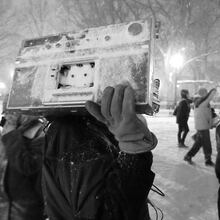It never feels good to be told there’s an incredible place that is off-limits to you (and most of the world’s population). In Georgia, there are a few such places where access is limited or outright denied.
Here’s a list of eight spots from around the state that will probably remain unchecked on your bucket list.
1. The tunnels of Georgia Nuclear Aircraft Lab
The Cold War was a strange time.
Over the years, details emerged of surprising military projects across the globe, such as an ice fortress in the North Pole and Russia's (serious) plan to reverse the ocean currents.
But at least one project during this era hit close to home. In the early 1950s, the U.S. Air Force and Lockheed Martin quietly built top-secret nuclear reactors in a forest near Dawsonville. The reactors were used to irradiate various pieces of military equipment, to test if a nuclear-powered bomber was feasible.
According to reports, one of the on-site reactors was "naked," meaning it had no shielding around it. Personnel would have to retreat to underground tunnels whenever it was turned on, and the radiation pollution caused the forest to lose its leaves.
At the end of 1971, Lockheed closed the facility. Most of the structures on the site were demolished and only a few remnants of the lab remain today.
Due to contamination concerns, the hot cell building was sealed up and is now surrounded by two fences. The entrance to the underground tunnels was also destroyed, but that hasn’t stopped people from trying to locate it.
2. Burns Club
Burns Club is one of the oldest gentleman’s clubs in Atlanta and unless you’re one of only 100 members – or on the guest list – your chances of getting through the door are slim.
The literary society was organized in 1896 to honor the works of famed Scottish poet Robert Burns. Club events are held at the Burns Cottage in Ormewood Park, which is the world’s only replica of Burns’ ancestral home in Scotland.
Over the years, the club’s roster has included governors, farmers, teachers, lawyers, clergymen and tradesmen. Membership is limited to space in the cottage to just 100 men. However, non-member males and females are welcome by invitation.
The monthly meetings are reportedly relaxed, and conclude with members "circling up" and singing "Auld Lang Syne." Several times a year, neighbors in the area are treated to the sound of bagpipes wafting down the street.
While the privately-owned cottage is rarely open to the public, the club did open its doors for a series of literary evenings to mark the cottage's 100th anniversary in 2010. With any luck, the public won't have to wait until 2110 for their next chance to see inside.
3. Bunker 13
Preparing for the worst by surrounding yourself with only the best? This could easily be the slogan for Bunker 13, a luxurious nuclear facility in southwest Georgia.
A drive to the property reveals two large perimeter fences and a secured gate monitored by a security camera, to prevent unwanted looks into the compound. Once inside, guests will find two, small concrete buildings on the surface. But the truly impressive part is beneath their feet.
About 45 feet below ground is a 40-room bunker, which can reportedly withstand a 20-kiloton nuclear blast.
The compound was built by the U.S. government during the Cold War, but today it's privately owned by government contractors. After $2.5 million in upgrades, the facility looks more like a Four Seasons hotel than a nuclear facility. However, only a select few can step inside.
Co-owner Martin McDermott told the AJC that the compound is currently being used as a “communications training center for government clients.”
Still, the owners may be willing to sell for around $9 million, McDermott added. So if an underground lair has been on your wish list, this could be the property for you.
4. NSA facility at Fort Gordon
It may come as little surprise that Georgia’s National Security Agency (NSA) facility made the list of off-limit places. After all, this is a department that is jokingly referred to as the “No Such Agency.”
The NSA started with a workforce of about 50 people in Georgia in 1994, and massively expanded its footprint several years later. The operations building at Fort Gordon now consists of more than 600,000 square feet and houses intercept operators, analysts and other specialists.
According to reports, the facility focuses on intercepts from Europe, the Middle East and Africa. Codenamed Sweet Tea, the center is used to gather intelligence and feed it to policy makers and military commanders.
During a tour of the super-secret operations center in 2012, WRDW News 12 in Augusta reported the building consisted of an enormous circular room that had the feel of "something you'd see in a James Bond movie." However, no cameras or cell phones were allowed during the tour.
The station reports their closest camera was allowed two miles from the building.
5. St. Catherine’s Island
If you’re not familiar with St. Catherine’s Island, which lies about 50 miles south of Savannah, you’re not alone. The privately-owned island is largely undisturbed and visitors are by invite-only.
From 1974 to 2007, the island resembled "a child's dream of Africa" where strange creatures – not humans – roamed the land, the Los Angeles Times reported. The interior of the island operated as a breeding facility for rare and endangered species, such as Grevy zebras, Arabian oryx and ring-tailed lemurs.
In the mid-2000s, approximately 435 of the animals were settled in new zoos across the country. The Bronx Zoo explained its original program goals had been met, which led to the center's closure. Few of the breeding facilities are in use today.
Since the entire island was declared a National Historic Landmark, educators and scholars use St. Catherine's to study Georgia's coastal ecology and 6,000 years of human history. More than 1 million artifacts found on the island were stored and exhibited at the Fernbank Museum.
While the interior of the island is off-limits, a beach trip to the island is still possible. By state law, all of Georgia’s barrier island beaches to the high tide line are open to the public, including St. Catherine’s.
6. Atlanta Prison Farm
In southeast Atlanta, a property twice the size of Piedmont Park has been slowly decaying for the past two decades. It’s also closed to the public, and curious visitors could be hit with a $1,000 fine.
The Atlanta Prison Farm opened during the early 20th century as an experimental minimum-security federal facility. Nonviolent inmates were allowed to cultivate livestock, tend crops and help feed fellow convicts.
The city of Atlanta took over the farm for half a century before closing it in 1995 - and nothing really took its place. In recent years, filmmakers have used the graffiti-covered site as a gritty backdrop, such as in the Arnold Schwarzenegger movie "Sabotage."
Following a fire at the property last October, the site became increasingly dangerous. Some have reported obscure holes that open into the generator housed many feet below. DeKalb police regularly patrol the area and will give out citations to people driving on or exploring the property.
7. UGA practice sessions
While fans of many SEC teams are allowed into at least some preseason football practices, that isn’t the case for University of Georgia. The team’s early workouts are kept under wraps.
So what’s to hide?
As Georgia coach Mark Richt explained to Savannah Morning News in 2013, "Early on when it's mostly fundamental and all, you still may have a couple of new plays that you're running."
“The normal fan may not get it, but if somehow it’s videoed or whatever, and it gets on the Internet and the GA or somebody … looking at that stuff says, ‘Hey, man, I just saw this at their practice and it looks a little bit different.’ You might want to line up (Jadeveon) Clowney a different way. I don’t know if I’d want everybody to see (how) I’m lining him up.”
Georgia also asked the media to not post any audio from video shot at practice online, so things like snap counts won’t get out. Reporters have entertained themselves by adding music to the footage, Savannah Morning News reports.
8. World of Coca-Cola Vault
This list probably wouldn’t be complete without the World of Coca-Cola Vault.
In 2011, Atlanta-based Coca-Cola hid its biggest secret in plain sight (sort of). The beverage company retrieved its recipe from a vault at SunTrust Bank and reportedly transferred it a few minutes down the road to a new high-tech vault at the company's World of Coca-Cola exhibit.
The vault is never opened and is protected by a barrier that keeps the viewing public several feet away. There’s also a keypad and hand-print scanner by the door. But officials haven’t confirmed if these are simply for show.



